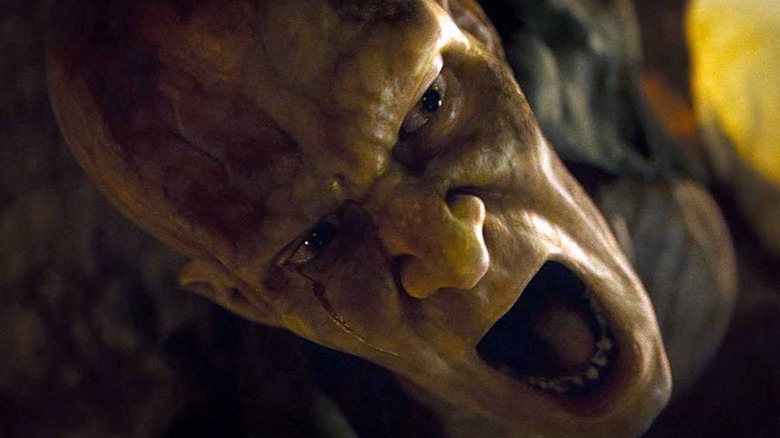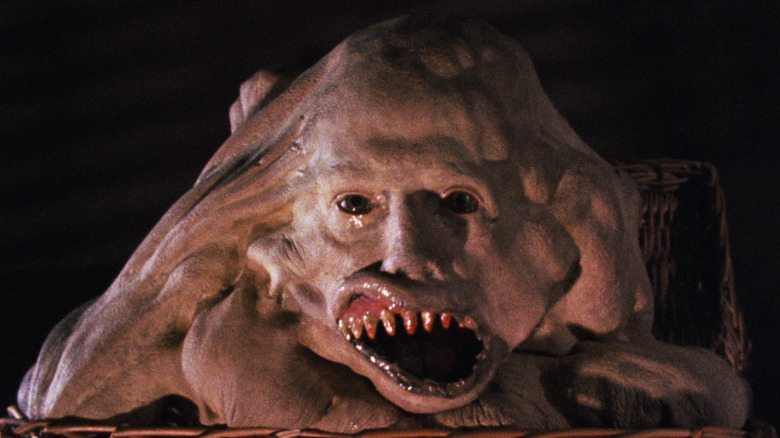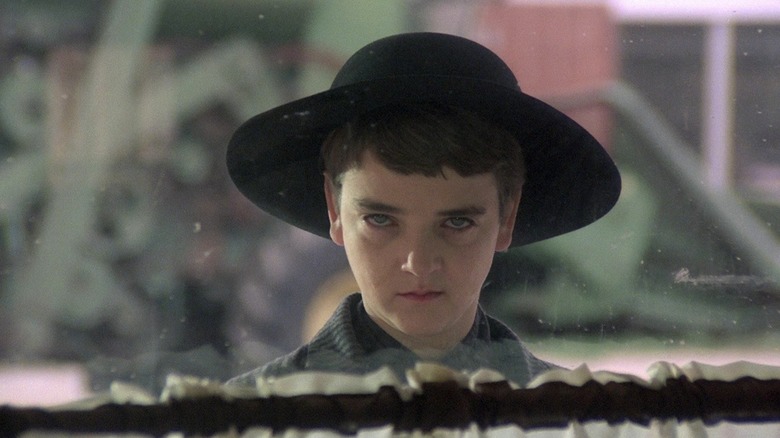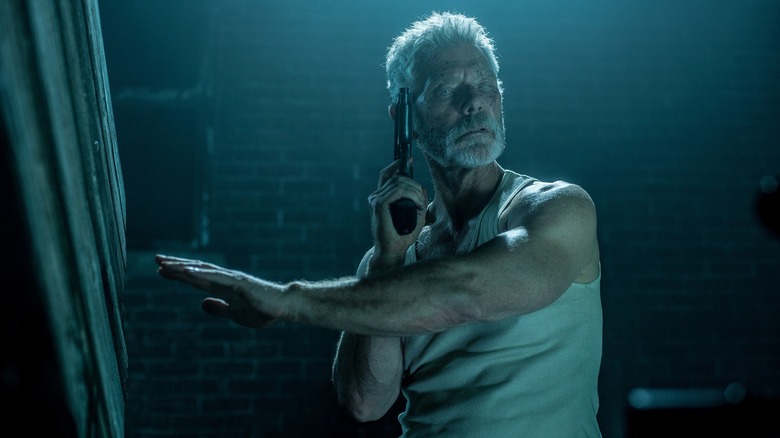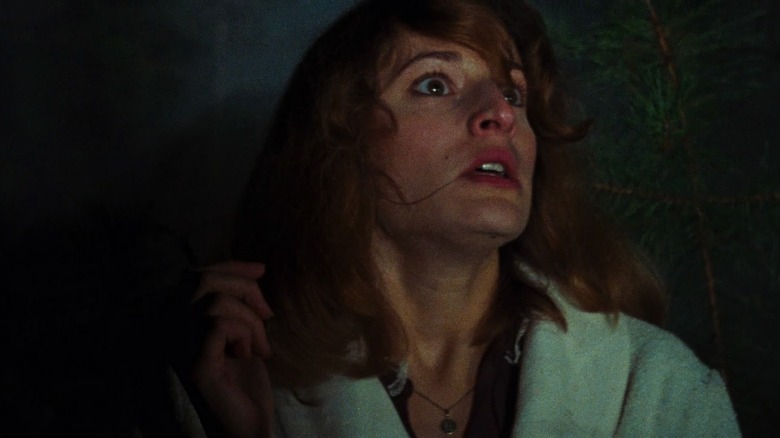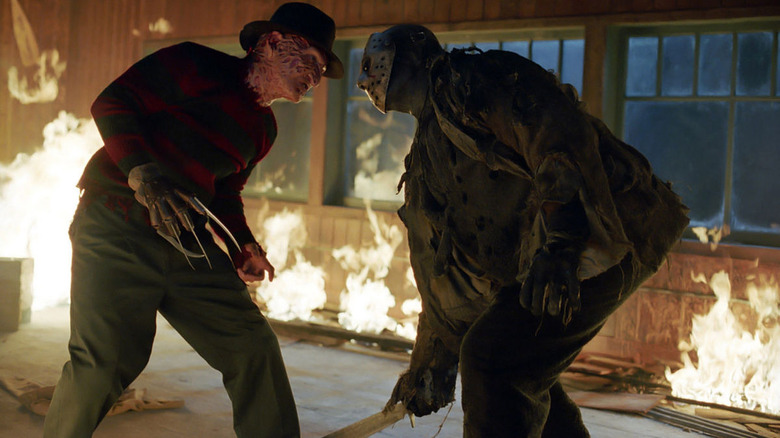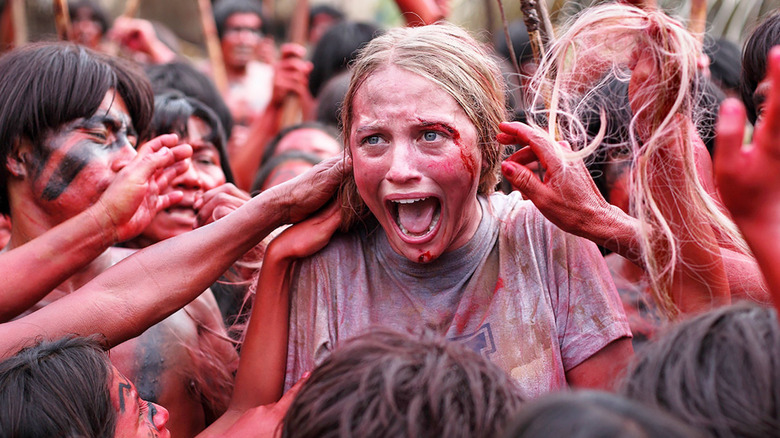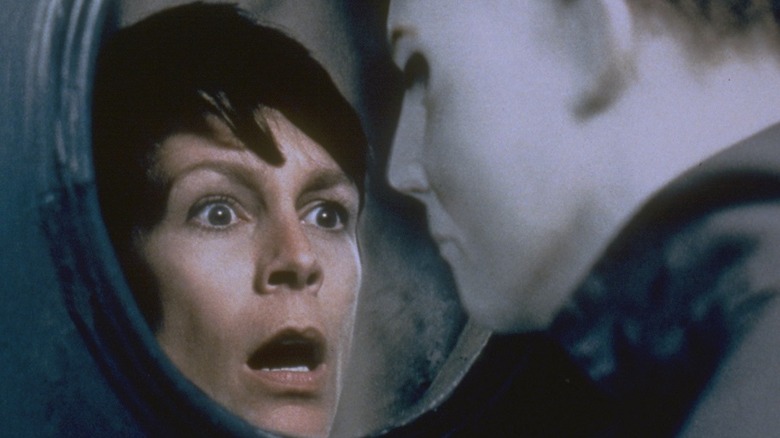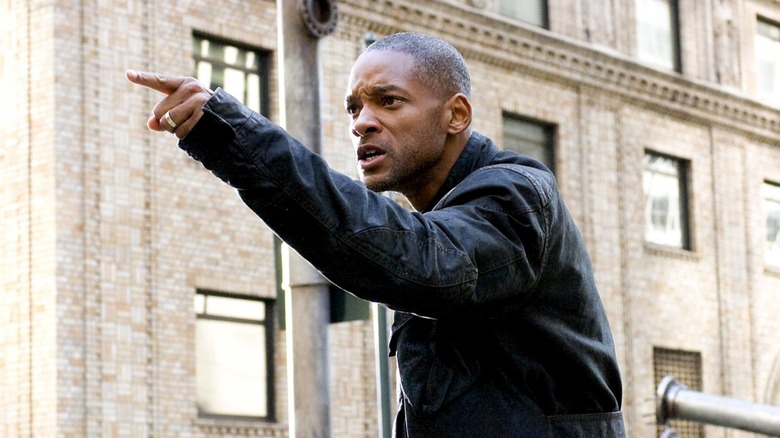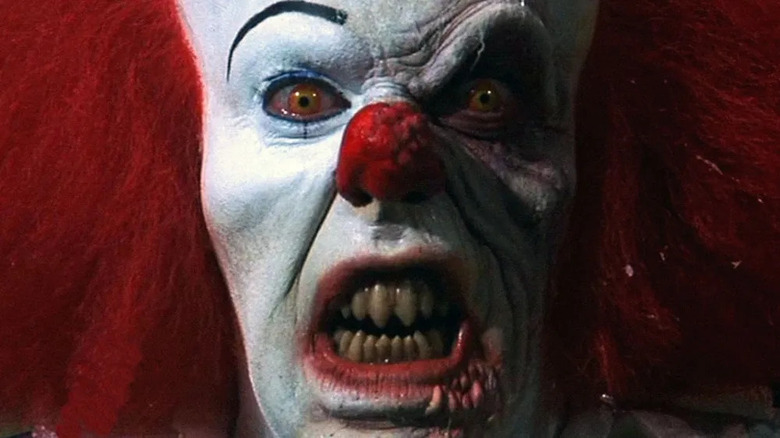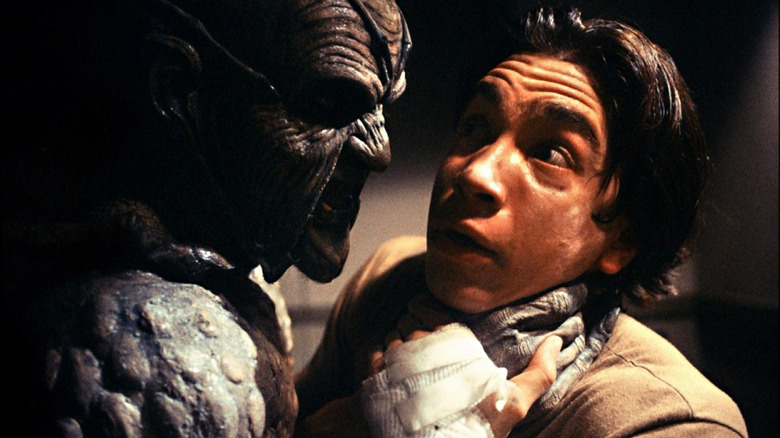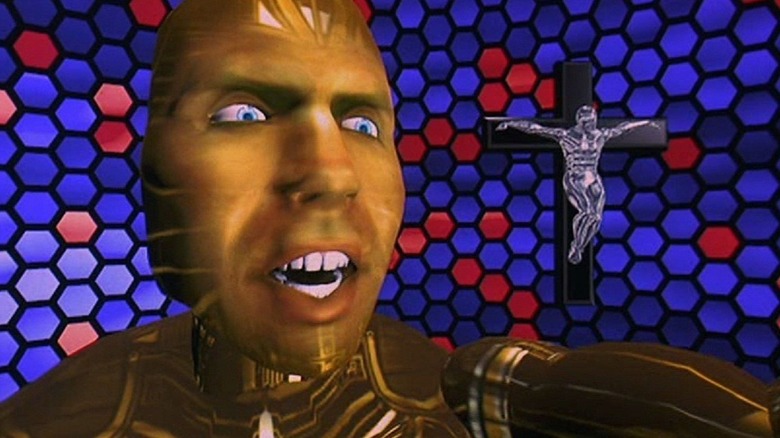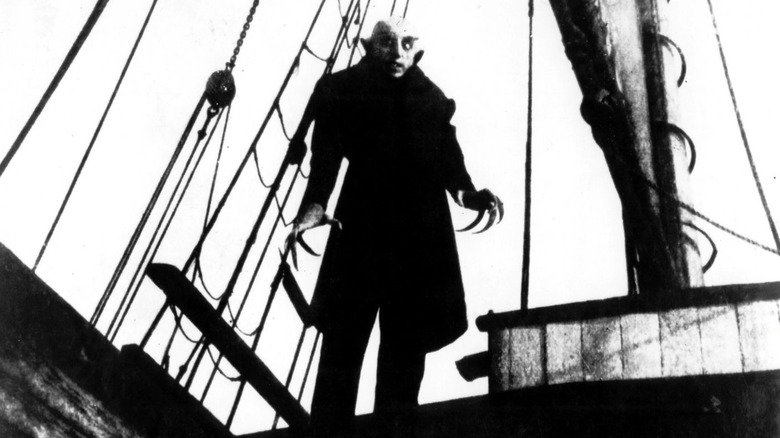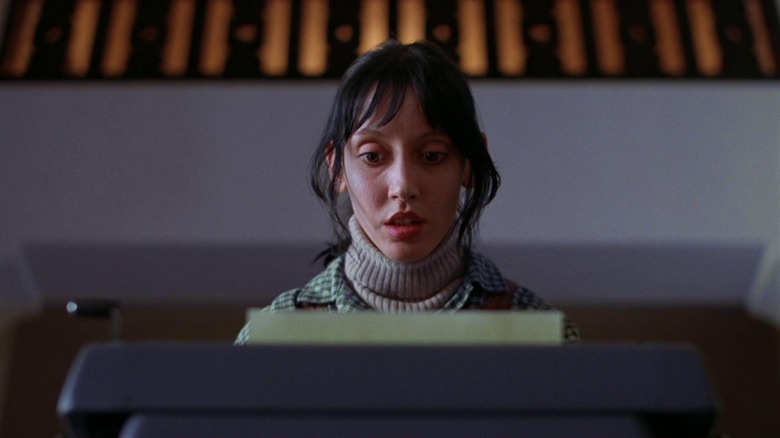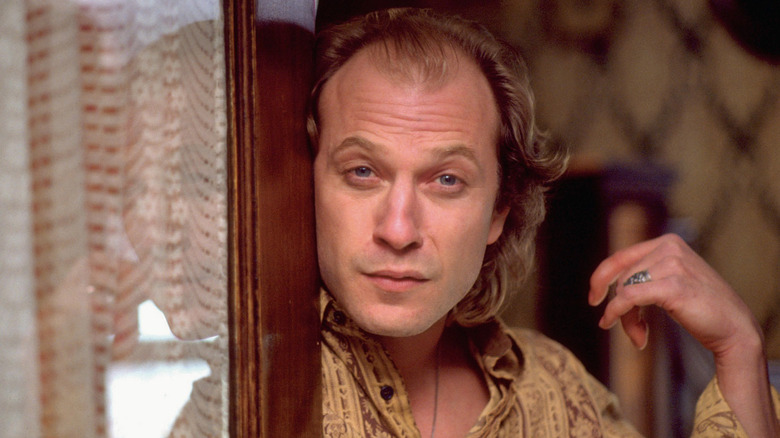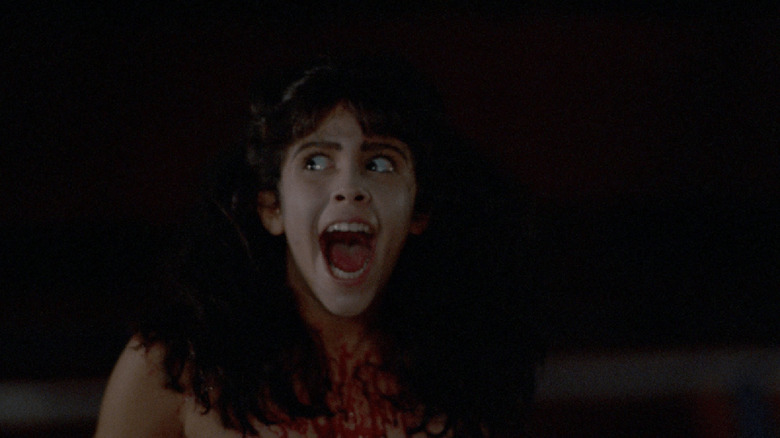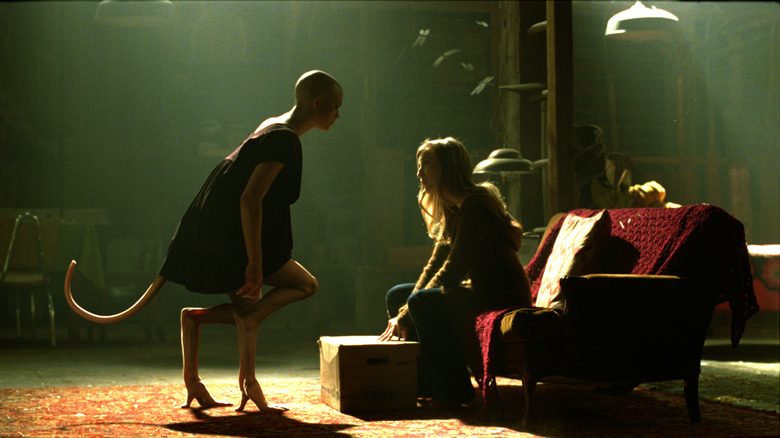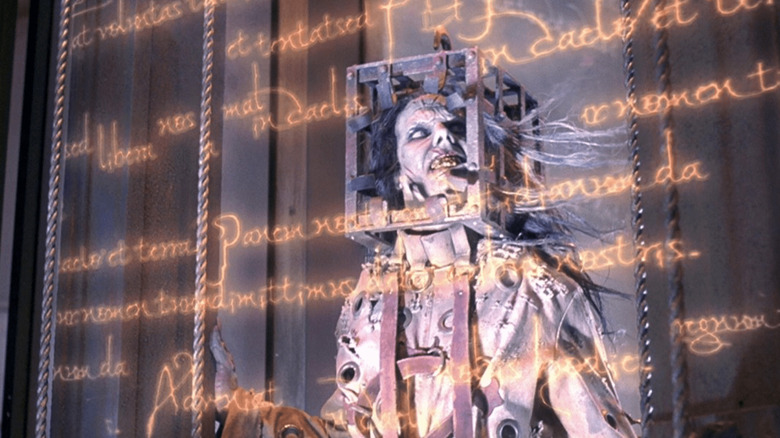17 Horror Movies That Haven't Aged Well
Sometimes, talking about art that "hasn't aged well" is an exercise in punching down. But you'll never see us make fun the perfectly imperfect stop-motion special effects of the original "King Kong," or the arch, gothic grandeur of classic Universal monster movies. When you meet old art halfway, it's magical — the greatest movies from different eras offer a chance to communicate with the past, an opportunity to engage in pop culture time travel.
But this list of horror films the /Film crew has assembled here? Well, it's a bit more complicated with these movies.
We love some of these horror movies. We hate some of these horror movies. We have mixed feelings about some of these horror movies. But they all have one thing in common: at least one aspect of them has aged like a glass of milk on a hot summer day. Whether it's visual effects that haven't stood the test of time or story elements that register as profoundly icky or even offscreen elements that make the movie hard to watch these days, here are 17 horror movies that haven't aged too well.
Basket Case
There's a cult following for director Frank Henenlotter's conjoined-twin horror flick, "Basket Case," but its final scene ruins whatever twisted joy could otherwise be found. "Basket Case" follows conjoined twins Duane (Kevin Van Hentenryck) and Belial (a puppet) as they wreak havoc on anyone who crosses them. Duane and Belial are separated by a trio of doctors, whom they then kill, and things only deteriorate from there.
"Basket Case" has its fair share of dark humor, and even some of its murders are played for laughs. The problem comes when Belial attempts to rape Duane's girlfriend, Sharon (Terri Susan Smith.) Belial, whose hatred of the world has been somewhat understandable, crosses the line from being a bitter misfit to an actual monster. Any sympathy for the character goes right out the window, and is only made worse when Belial kills Sharon after she tries to fight him off. While some viewers might find humor in a misshapen creature with no legs trying to rape someone, the scene is gut-churning and comes out of nowhere. Sharon's terror is given the most focus, followed by her body. It's exploitative at best and downright leering at worst, making the whole thing feel even more horrendous.
The shifting tones and B-movie grizzle of "Basket Case" both age the film, but nothing makes it unwatchable quite like that ending sequence. Rape isn't just a plot point, and it certainly shouldn't be a punchline. It's a real shame, too, because the gonzo weirdness of "Basket Case" is a lot of fun, and this movie could have been a cult classic to love. (Danielle Ryan)
Children of the Corn
Stephen King's macabre stories have been the catalyst for many incredible horror movies, but "Children of the Corn” is not one of them. The short story that inspired the movie was first published in the softcore magazine Penthouse in the '70s, which tells you everything you need to know about the schlocky, taboo-breaking and incredibly cheesy plot. The 1984 movie takes place in the solitary, religious, and fictional town of Gatlin, Nebraska. After the town's corn crops fail, 12-year-old Isaac takes it upon himself to indoctrinate the town's children into his cult, which worships a monster that lives among the corn. Under the watchful eye of Isaac, the children massacre all of the adults in town and live out their days luring strangers into their cornfield, sacrificing them to the monster and participating in demonic blood rituals. When a young couple finds one of the town's children dead on a stretch of empty highway nearby, things begin to go off the rails for Isaac and his biblically named cult members.
Despite its outlandish plot, "Children of the Corn” has a lot going for it. The story harkens back to "Lord of the Flies," but turns the basics of the story on its head, portraying Isaac's cult as a fairly organized, if incredibly sadistic, society that has met their goal of reviving the corn fields. Unlike in "Lord of the Flies," the beast who lives in the corn crops is real and is portrayed by some of the worst special effects you've ever seen. When combined with the horrible child voice overs, the comedic over-acting and trite film cues, "Children of the Corn ” could not feel more dated. This "Lord of the Flies” riff might be good on paper, but the film comes coated with a greasy slice of 80s cheese. It's downright ... corny. (Kaylee Dugan)
Don't Breathe
When "Don't Breathe" first came to theaters it was widely lauded for its tightly constructed suspense. Suspenseful it was, but the tale of some hapless thieves who fell into a blind predator's den and get a whole bunch more than they bargained for is built around an extremely ill-advised plot twist. The blind man at the story lost his daughter in a car accident. So he subsequently kidnapped the female driver who killed her in hopes of impregnating her with a turkey baster to give him a replacement daughter. It's one of the most disturbing, disgusting, and avoidably wrong storyline twists in recent memory.
Here's the thing — the violation of sexual autonomy here is heinous and needless. They could have gone with any of a number of other ways to exhibit the antagonist's menace, but they chose an archaic plot device to shock modern audiences, one that grows more grotesque the longer you think about it. It's also a bit conceptually odd that the entire film rests around the conceit that the blind antagonist effectively has superpowers, making this yet another instance of othering and villainizing disability. If you break down the story, there's really nothing central to "Don't Breathe" that works in our contemporary landscape. What's worse, it spawned a sequel that fails to follow our female protagonist in finishing off said disturbing antagonist and instead follows the film's antagonist, transforming him an anti-hero. As bad as the original is in its implications, treating that antagonist as a salvageable protagonist is so much worse. Perhaps it would be better if it was named "Don't Watch." (Jeff Ewing)
The Evil Dead
Sam Raimi's "The Evil Dead" was groundbreaking in a lot of ways, paving the way for indie horror throughout the 1980s, but one scene probably should have been left on the cutting room floor. The hyper-violent romp had no shortage of blood, guts, and gore, but it also has a completely unnecessary rape scene. The first victim of the titular evil dead is Cheryl (Ellen Sandweiss), who is chased through the woods before being sexually assaulted by a tree. The sequence is graphic, focusing on Cheryl's abject terror as vines hold her limbs apart. She tries to cover her naked flesh, and the vines yank her hands away. It's one of the more intense assault sequences out there, despite the fantastical elements.
In an interview with the San Diego Reader in 2012, Raimi expressed his regret over the scene:
"I think it was unnecessarily gratuitous and a little too brutal. And finally because people were offended in a way that I didn't...my goal is not to offend people. It is to entertain, thrill, scare ... make them laugh, but not to offend them."
It's unfortunate that the 2013 reboot directed by Fede Álvarez also included a tree rape sequence, though the director was allegedly required to include it by a producer. At least the Starz series "Ash vs. Evil Dead" gave us some justice for Cheryl, with Sandweiss returning in the role and having a few choice words about her experience in the forest. "The Evil Dead" is an all-time horror classic, but that scene is totally unnecessary. (Danielle Ryan)
Freddy vs. Jason
Director Ronny Yu's 2003 slasher flick "Freddy vs. Jason" was the long-awaited, epic showdown between two horror movie icons: The perverse, child-murdering Freddy Krueger from "Nightmare on Elm Street," and the silent-but-deadly Jason Voorhees of "Friday the 13th." For all the hype the film received, "Freddy vs Jason" hasn't really aged well, and so much of what poorly ages the horror feature lies in the unnecessary.
One of these unnecessary elements is the objectively bad CGI, like Freddy taking the form of a talking caterpillar, serving us poorly rendered "Alice in Wonderland" meets 1996 "Resident Evil" video game visuals. To make matters worse, the terrible effects looks especially out of place juxtaposed against the impressive practical effects that are present throughout the film.
Another hair-raising element is the unnecessary bigotry. Freddy Krueger calls Kelly Rowland, the one Black lead, "dark meat." In response, Kelly Rowland calls Freddy Krueger a gay slur. Specifically, "f*****."
The final offense is far less severe, but still visually appalling: That awful wig Rowland wears during the movie. Thankfully, wig quality has come a long way since then, but it's still pretty terrible, even for its time. None of this is to say that I hate or even dislike the movie; it's a lot of fun despite its many, many shortcomings. It has just failed to age well under the weight of its own excess. (Deshawn Thomas)
The Green Inferno
Horror director Eli Roth has been very open about his love of cannibal films, even going so far as to casting Ruggero Deodato, the director of "Cannibal Holocaust" to play a cannibal member of the Elite Hunting Club in "Hostel 2." In 2013, Roth finally made his own cannibal film, "The Green Inferno," inspired by the explosion of Italian cannibal films of the late 1970s and early 1980s. Roth chose to format "The Green Inferno" similarly to "Cannibal Holocaust," by featuring a film-within-a-film of streamed footage. The film follows a group of environmental activists who plan a trip to the Amazon rainforest to try and stop a petrochemical company from deforesting the area and displacing the indigenous tribes by streaming footage to raise awareness of their cause.
Unfortunately, much like the filming of "Cannibal Holocaust," there were a number of ethical and humanitarian concerns that weren't taken into consideration while Roth was filming. "The Green Inferno" was heavily criticized by Survival International, who felt the film reinforced neocolonialism and perpetuated stigmas against indigenous peoples living in voluntary isolation by portraying them as "savage." Typically cannibal films are meant to critique the white savior behavior of colonialists, but because of the film's extreme nature, the film comes off as far more critical of indigenous tribes as nothing more than unintelligent and dangerous. Roth dismissed these claims, believing that corporations continually tear apart indigenous communities regardless of how indigenous people are portrayed, and called their criticisms "misdirected anger and frustration." The film remains banned in many countries due to its extreme depictions of blood, violence, and gore. (BJ Colangelo)
Halloween H20: 20 Years Later
"Halloween: H20" felt like a gigantic deal in 1998. It brought Jamie Lee Curtis back as Laurie Strode 20 years after John Carpenter's original slasher classic hit theaters. It moved beyond the bizarre and increasingly wacky events of the fifth and sixth entries in the series. There was plenty of reason for horror fans to be excited, and it was probably a fun watch when it first came out. The problem is, elements of the movie have aged extremely poorly, though some of that can't necessarily be blamed on the movie itself.
The idea of Michael once again confronting Laurie, traumatized by the events of her past, was executed far better in 2018's "Halloween," which ignored every previous sequel in the franchise. That is perhaps the biggest hurdle that "H20" has to clear in the modern context. It is doing the same thing that another movie did better in almost every way. On the nitty-gritty side of things, this movie, unfortunately, just doesn't look very good from a production standpoint and it shows its age. Of note, the Michael Myers mask in this entry is particularly terrible and almost laughable at times, with the killer looking like he is bulging out of it for much of the movie. Many fans of the series will argue that the "Halloween 4" mask is the worst of the bunch, but the "H20" mask is right there with it, and it's hard to buy a "Halloween" movie when Michael's signature look is this off base. (Ryan Scott)
I Am Legend
There are a handful of issues to be had with "I Am Legend." The 2007 adaptation of Richard Matheson's masterpiece horror novel defangs the source material's grim and brilliant ending in favor of something blandly Hollywood, for instance. But for much of its running time, there's no denying it: the movie works, and it works well. Director Francis Lawrence builds incredible tension out of the premise — a man and his dog, alone in a monster-haunted post-apocalypse — and the sense of place, the sense of isolation, and the sense of loneliness and loss, is palpable. It's all anchored by Will Smith, who brings his A-game and allows himself to be broken, vulnerable, and painfully human, a case where the biggest movie star on the planet actually acts in a blockbuster movie.
But then we get a closer look at those monsters. When they're hidden or draped in shadows, they're fine. Then they step into the light and reveal themselves to be the least-scary element in the entire movie. With their rubbery skin and gaping mouths stolen right from 1999's "The Mummy," these mutants look like characters from a PlayStation game or radioactive rejects from "The Polar Express," pixelated abominations at odds with literally everything else onscreen. Their every appearance stops the movie dead in its tracks, forcing each viewer to ask the obvious: were these digital creations really worth the trouble instead of actors wearing gruesome horror make-up? In 2007, fully-CGI monsters weren't ready for primetime. 15 years later, they torpedo a pretty good movie into oblivion. (Jacob Hall)
It (1990)
The first screen adaptation of Stephen King's "It" came in the form of a television miniseries that debuted on ABC in 1990. While the miniseries isn't a bad take on the novel, the limitations that came with creating a horror series under TV censorship guidelines and a small budget are particularly apparent in retrospect. For instance, a lot of the graphic violence in the novel wasn't allowed to air on television, such as Pennywise tearing off Georgie's arm. Additionally, ABC wouldn't allow blood to be shown "coming out of body orifices," which resulted in blood coming out of inanimate objects like balloons and photo albums instead.
Further dating the "It" miniseries are the cheesy special effects that just don't hold up over time. To be fair, the special effects probably weren't destined for greatness on a late-80s made-for-TV budget, so it ends up being visually similar to a really long episode of "Goosebumps" with its jarring, unintentionally hilarious stop-motion animation and that giant spider prop that ends up looking goofy and unimpressive during a key climactic sequence.
Further adding to the "Goosebumps" vibes of the "It" miniseries are the melodramatic performances of the adult actors, making it feel like 50% self-parody and 50% soap opera. That said, Tim Curry's Pennywise is still fantastically fun and frightening. He's the one element that has aged well.
Curry's creepiness aside, the scares in "It" just aren't scary over 30 years later. The series manages to drag on while simultaneously being too short to do the story justice in the way the 2017 and 2019 adaptations do. Ultimately, the "It" miniseries is very clearly a product of its time that turns King's horror novel about childhood trauma into more of a wholesome after school special rather than a full-bodied horror affair. (Deshawn Thomas)
Jeepers Creepers
With a wacky plot that centers around a demon with a penchant for custom license plates and a love of jazz standards, it's easy to write off "Jeepers Creepers" as being dated for being silly. The 2001 movie follows a brother and sister who are driving home together during college break. During their road trip, they're passed by an aggressive driver, who they later see dumping a bloody sheet down a giant pipe. They stop to investigate and are caught in the web of "The Creeper," a flying demonic entity that is attracted to fear and stalks them as they try to get help. While "Jeepers Creepers" features a few incredibly intense scenes, effective scares, and impressive gore, it really is silly. The story is overwrought, convoluted, and filled with more than a few one-note characters.
However, "Jeepers Creepers" hasn't only aged poorly because of its plot, but largely due to director Victor Salva's criminal actions. In 1988, Salva was convicted of molesting one of the child stars in his film "Clownhouse," as well as possessing child sexual abuse material. He only served 15 months, although he had been sentenced to three years. After leaving prison, Salva quickly made his way back into the film industry, where he went on to direct nine more movies, including "Jeepers Creepers" and its sequels. The story of "Jeepers Creepers" isn't one of a quirky brother and sister team who put their lives on the line to stop an evil creature, it's the story of a pedophile who served minimal time and was welcomed back into Hollywood. It's the story of a predator who was prioritized over his victims. "Jeepers Creepers" hasn't only aged poorly, it shouldn't exist to begin with. (Kaylee Dugan)
The Lawnmower Man
Okay, so the computer graphics in the 1992 sci-fi horror flick "The Lawnmower Man" were never acclaimed for being great, even in their time, but they've aged so badly by now that it's actually kind of impressive. The movie was directed by Brett Leonard and stars Jeff Fahey as Jobe Smith, a gardener with intellectual disabilities who undergoes experiments to give him superpowers. The CGI is bad, Fahey's performance is cringe-worthy, and the whole movie is just a big ol' mess.
The movie was originally titled "Stephen King's The Lawnmower Man," but the horror author sued to have his name removed due to the complete lack of connection between his short story of the same name and the film. "The Lawnmower Man" has aged spectacularly poorly in multiple ways, from its depiction of cybersex to computer-generated images that look more like a Dire Straights music video than a feature film from almost a whole decade later. The worst of it is Fahey's performance, however, which is closer to Ben Stiller's "Simple Jack" character from "Tropic Thunder" than any real depiction of someone with an intellectual disability. Jobe Smith is a caricature created entirely out of poor taste, and it makes the bad CGI seem like almost a terrifying afterthought.
A James Bond-era Pierce Brosnan stars alongside Fahey as the scientist who's conducting the experiments on Smith, and this is one of the first introductions of virtual reality in cinema, but good God, just go watch Cronenberg's "eXistenZ" instead. At least then you'll want to claw your eyes out for interesting reasons. (Danielle Ryan)
Nosferatu: A Symphony of Horror
Not unlike its unofficial namesake, F. W. Murnau's "Nosferatu" is pretty xenophobic. More specifically, it's incredibly antisemitic.
Nearly all of Europe leading up to and including the early 1920s was a hotbed of antisemitic rhetoric, influencing a great deal of the public's social and political engagement. The Dreyfus Affair started in 1894, and the Beer Hall Putsch would happen the year after "Nosferatu" was released. We all know what happened throughout Europe after that.
"Dracula" was notoriously xenophobic, emphasizing some of the more racist anxieties prevalent in 19th century English society including the fear of encroachment by foreigners. Count Dracula himself was the personification of those fears.
Murnau and producer Albin Grau's Count Orlock (Max Schreck) took Dracula a step further. Where the latter could shape-shift into a bat or a wolf — the notion of shapeshifting in this context already rooted in xenophobia — Murnau and Grau opted to have Orlock transform into a rat, something Jewish people at the time (and to this day) were often referred to as. We were also often referred to as vermin, carriers of pestilence and consumers of all that lay before us. Orlock spends the film buying up all the property he can get his hands on, and spreading disease wherever he goes.
On top of this, Orlock's physical features were overtly antisemitic, pulling from the many, many, many antisemitic caricatures that predate the film's release, not to mention those that would come after. Eventually, this would include the Nazi party and be used as antisemitic propaganda. His long fingers, hunched back, and elongated hooked nose had been used for centuries to dehumanize Jewish people.
In 1922, they were used to sell movie tickets. And no one batted an eye. (Ariel Fisher)
The Shining
Love it or hate it, "The Shining" is one of the most famous horror films of all time. Based on the story by Stephen King and directed by industry giant Stanley Kubrick, "The Shining" has been both lauded and heavily criticized since it was released in 1980. Considering the film's affecting environment, early adoption of cutting edge film technology, and striking cinematography, the praise is well-deserved, but when you factor in the stilted characters, racist tropes, and Shelly Duvall's bad experiences working with Kubrick, the criticism rings true.
The film tells the story of the Torrence family, who move into the grand Overlook Hotel after father Jack Torrence is hired as the off-season caretaker. While things are finally starting to look up for the Torrences, the family we meet in the beginning of the film is already in crisis. Jack's wife Wendy and their son Danny have been physically and mentally abused by Jack, who is an alcoholic. Of course, things take a turn for the worse as the solitude, and ghostly spirits, in the hotel itself drive Jack mad. Danny and Wendy's only saving grace is Danny's magical powers, which include premonitions and telepathy. Those magic powers connect Danny to the Hotel's chef Dick Hallorann, who embodies the racist archetype of the "magical negro" in Kubrick's and King's story. Hallorann is portrayed as a tour guide for and a savior of the Torrence family, a minimized role that only shows Hallorann in their service. He's also the first and only character killed on screen, which recalls another racist horror trope.
The well-earned criticism doesn't end there, Shelly Duvall, the actress who played Wendy, has described the overwhelming emotional intensity Kubrick required on set, as well as the hundreds of takes he demanded. Essentially, it seems like an arduous process that targeted Duvall more than the rest of the cast. "The Shining" might be an important horror movie, but parts of it feel as old and neglected as the halls of the Overlook Hotel. (Kaylee Dugan)
The Silence of the Lambs
To say "The Silence of the Lambs" is a beloved film is an understatement. In addition to its pop culture influence inspiring parodies everywhere from "Clerks 2" to "Family Guy," the film has also been turned into a spoof musical, spawned a successful franchise of films, and there surely would be no "Hannibal" TV series if it had not been for the success of this film. The film follows Jodie Foster's FBI agent-in-training Clarice Starling as she races against the clock to solve the case of a possible serial killer called Buffalo Bill, seeking assistance from a gifted psychologist named Dr. Hannibal Lecter, who is locked away for his own history of murder and cannibalism.
While today the conversations surrounding "The Silence of the Lambs" are focused on the "copaganda" of a film glorifying FBI Agent Clarice Starling or the blatant transphobia of the characterization of Jame Gumb/Buffalo Bill, the film had its fair share of protests in 1991-1992, with the Gay and Lesbian Alliance Against Defamation (GLAAD) and gay critics believing audiences would read Jame Gumb as a gay man, and treat gay people in real life accordingly. As our language evolved surrounding gender identity and the transgender experience, so too have our discussions surrounding Jonathan Demme's masterpiece. Unfortunately the public consciousness' view of trans people was greatly influenced by the portrayal of Jame Gumb, with some conservative pundits even nicknaming anti-trans legislation, "Buffalo Bills." It's important to remember that although "Silence of the Lambs" is an absolute masterclass in filmmaking, its problematic legacy still shines as brightly as all of the trophies it earned. (BJ Colangelo)
Sleepaway Camp
Released in 1983, the cult-classic "Sleepaway Camp" is best remembered as a low-budget disaster featuring wildly inappropriate adult camp staff, the cruelest pre-teen campers ever captured on film, and an infamous ending that has been the subject of debate for almost 40 years. The love and following for the film lie predominantly with the campy nature of this summer camp slasher, but its "shocking" and downright problematic ending solidified its cult status. The film follows a simple slasher formula, where an unseen force kills campers and counselors one by one, in progressively weirder ways. When the killer is revealed, we see the teenaged Angela standing nude and groaning like an animal, and as camp counselor Ronnie exclaims, "My god ... she's a boy!" As it turns out, Angela is not Angela, but her brother Peter who was forced to live as a girl by his Aunt Martha.
The ending is wildly problematic for perpetuating the "dangerous transgender" myth, implying that Peter and Angela's deceased father was a gay man and was therefore not allowed to raise children, and for showcasing the fully nude body of an underaged child. On the surface, "Sleepaway Camp" is absolutely a transphobic and homophobic movie, but the film also serves as an incredible metaphor for how forcing gender roles onto someone that doesn't align with who they are is dangerous. Even in the ugliest moments of films, there's always something that can be savored if we can look for the nuance. The horror in the ending of "Sleepaway Camp" is not that Angela was assigned male at birth, the horror is recognizing that we've been watching a child who has been abused and mentally tortured for years, and that this child is in desperate need of help. (BJ Colangelo)
Splice
A weird little gem of genetic horror, Vincenzo Natali's 2009 film "Splice" has a repulsive reputation. It follows the groundbreaking exploits of two married geneticists, played with twisted gusto by Adrien Brody and Sarah Polley, whose primary interest involves splicing animal DNA and making uncanny hybrids for scientific study. While they become famous for creating vermiform (or worm-like) creatures named Ginger and Fred, their prized creation is Dren, a humanoid female who also possesses backward-bending legs, retractable wings and a long, fleshy tail with a stinger (hello, Cronenberg's "Ravenous"). Needless to say, the couple's version of Frankenstein's monster (their names Clive and Elsa clear homages to the 1931 film) comes with equally disastrous consequences.
What makes "Splice" so enduringly controversial are the film's sex scenes, all of which toy with abhorrent human taboos of incest, rape and pedophilia. One of these exchanges involves Dren secreting a pheromone in order to "seduce" her adoptive father, who succumbs to the scent. Though this scene is certainly hard to stomach, it's just scratching the surface. The film's climax involves Dren morphing into a male, a surprising evolutionary tool used to rape and impregnate Elsa. Though she manages to kill her genetically mutated spawn during the ordeal (but not before Dren kills Clive), Elsa chooses to carry the hybrid seed to term after being offered a hefty sum by the scientific community.
Easily remembered as one of the ickiest film that came from the era (which is saying a lot), Natali did preemptively warn audiences that "there's sex...very, very unconventional sex." It's totally valid if the film's shocking elements personally outweigh any potential commentary on the future of eugenics it's conveying. But either way, the wild narrative choices and sickening visual effects that drive "Splice" certainly won't be seen again anytime soon. (Natalia Keogan)
Thir13en Ghosts
A definite product of the era it was re-imagined in, the 2001 Dark Castle Entertainment production of "Thir13en Ghosts" is far from the best horror movie of the 2000s. Yet this is exactly why the film has garnered a dedicated fanbase in the 20 years since its release — a faction that has far outweighed the film's original detractors.
Based on the 1960 film of the same name directed by William Castle (the namesake of the production company), director Steve Beck took ample creative liberties to bring the plot into the new millennium. The film follows Arthur, a recent widow (played by national treasure Tony Shalhoub), who inherits his Uncle Cyrus' eccentric mansion upon his death. The children Bobby and Kathy waste no time wandering the halls of their peculiar glass-walled abode, which they quickly realize is inhabited by, you guessed it — a ghoulish gaggle of ghosts. The ghosts were captured by Cyrus as part of his overarching plot for immortality, each spirit representing a figure of the "black zodiac." Arthur, his family, and Cyrus' former psychic assistant Dennis (verifiable icon Matthew Lillard) must stop Cyrus' plot before the phantoms bring him back to life.
There is no shortage of cringe-worthy material in "Thir13en Ghosts," namely the racist caricature of the nanny character Bess (played by Rah Digga) and the misogyny that plagues certain specters, with The Angry Princess perpetuating the "dead hooker" trope. Yet for all of the film's flubs, its bonkers set design, marvelously melodramatic performances, and careful creature design have earned it "cult classic" status — even if the plot is flimsy and its tropes are reductive. Sure, the wacky 2000s aesthetic of "Thir13en Ghosts" might make it a visual eyesore, but to others, it's a comforting slice of nostalgia that reminds us of a time when adaptations actually dared to be different. (Natalia Keogan)
